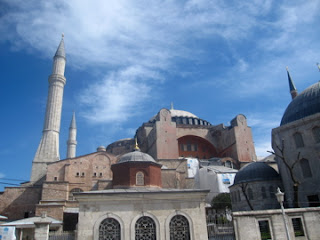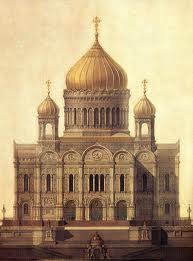 | |
| Originally a church, the Haga Sophia became a mosque. Today it is a museum in Istanbul. |
With all the fanfare over the election of a new Pope and in
anticipation of Easter and all the festivities leading up to it, I felt it
would be appropriate to write about the role Christianity has played in Russian
society. Since the 10th century Eastern Orthodox Christianity has
been observed as the official state religion of Russia. For those unfamiliar
with the Eastern Orthodox faith, it was once a part of Catholicism until
mid-way through the 11th century when both split into two separate
camps, Roman Catholicism based in Rome and Eastern Orthodox in Constantinople
(modern day Istanbul) until the fall of Constantinople when the church moved to
Moscow. Through the centuries and years there has been chatter about some type
of reconciliation or even reunification, but little if any progress has been
made.
From the 10th century until the 1917 October
Revolution when the Bolsheviks/Communists overthrew the Russian Tsar, The
Orthodox Church held a central role in Russian society. Once power was
consolidated amongst the Communists, the church suffered through a sixty plus year
period where its presence and influence was purged
from nearly every aspect of society. Supposedly the Communist government had a
state policy of tolerance toward religion, however the anti-religious actions
taken by the government contradicted this “tolerance”.
 |
| The original Christ The Savior Cathedral |
Probably the most
tragic example of Soviet intolerance toward religion occurred in 1931 when
Josef Stalin and communist officials targeted Moscow’s most famous church,
Cathedral of Christ The Savior, for destruction. The church had been built in
1883 by Tsar Alexander I to serve as a monument to the Russian people and the
courage shown in the face of Napoleon’s foreign army. What had taken forty-seven
years to build was gone in only a matter of a few days, wiped off the Moscow
skyline “forever”.
| The never built Palace of the Soviets |
In its place another
“cathedral” would rise, an over the top building called, The Palace of the
Soviets. On top of this massive structure would stand a 260-foot tall statue to
the father of the Soviet Union, Vladimir Ilyich Lenin. Once construction got
underway little progress was made due to the boggy nature of the soil and the
start of World War II. Eventually after many years of sitting only partially
finished the project was permanently abandoned and transformed into the largest
outdoor swimming pool.
| Lenin's body as seen today. |
Soviets tried
desperately to replace religion with Communist dogma making leaders such as
Vladimir Lenin into gods on earth. Upon his death in 1924 and against his dying
wishes, Lenin's body was embalmed so generations of Russians and tourists could pay their respects for years to come. Today one can view his “body”, which lies underneath an
airtight glass casket at the bottom of a large marble mausoleum in the heart of
Red Square. I write body in quotes since it has been widely speculated the real
body was removed years ago and replaced with a wax duplicate. I guess only the
elite team of scientists who are Vlad’s caretakers know the truth.
| A picture I took of an Orthodox church in the village of Pushkin. |
The long freeze on
religion started to thaw some in the mid-80s as Soviet officials loosened
restrictions on religion and worship. This in turn led to a re-birth of sorts
for the Orthodox Church with long closed churches being re-opened as full
places of worship. Citizens also started to take more of an interest in the church.
| A picture I took of the newly resurrected Christ The Savior Cathedral. |
And, in the early
1990s, there even began talk of re-building the glorious Cathedral of Christ
The Savior on the very sight it once stood. After several years of fundraising
and construction, the cathedral rose again, serving as a focal point for not
only Russian Orthodoxy, but for Moscow as a whole.
Since the fall of the
Soviet Union, the church’s influence has only grown larger. Now on major religious
holidays you will find most all of Russia’s leaders joining the masses at the
newly resurrected Christ The Savior Cathedral for worship, an action that
thirty years ago not only would have ended a politician’s career but possibly
their life.




